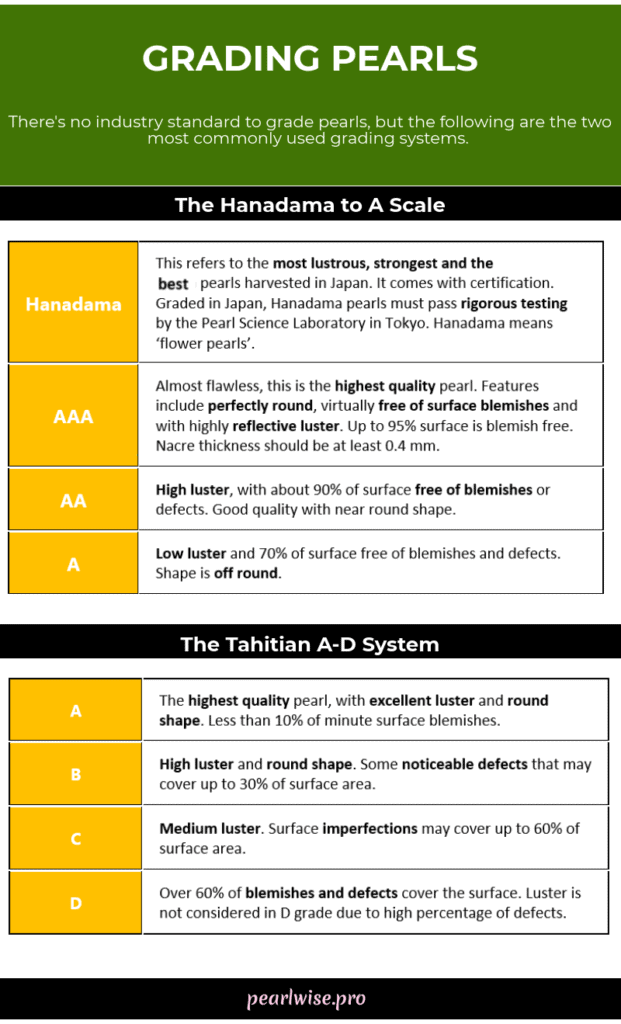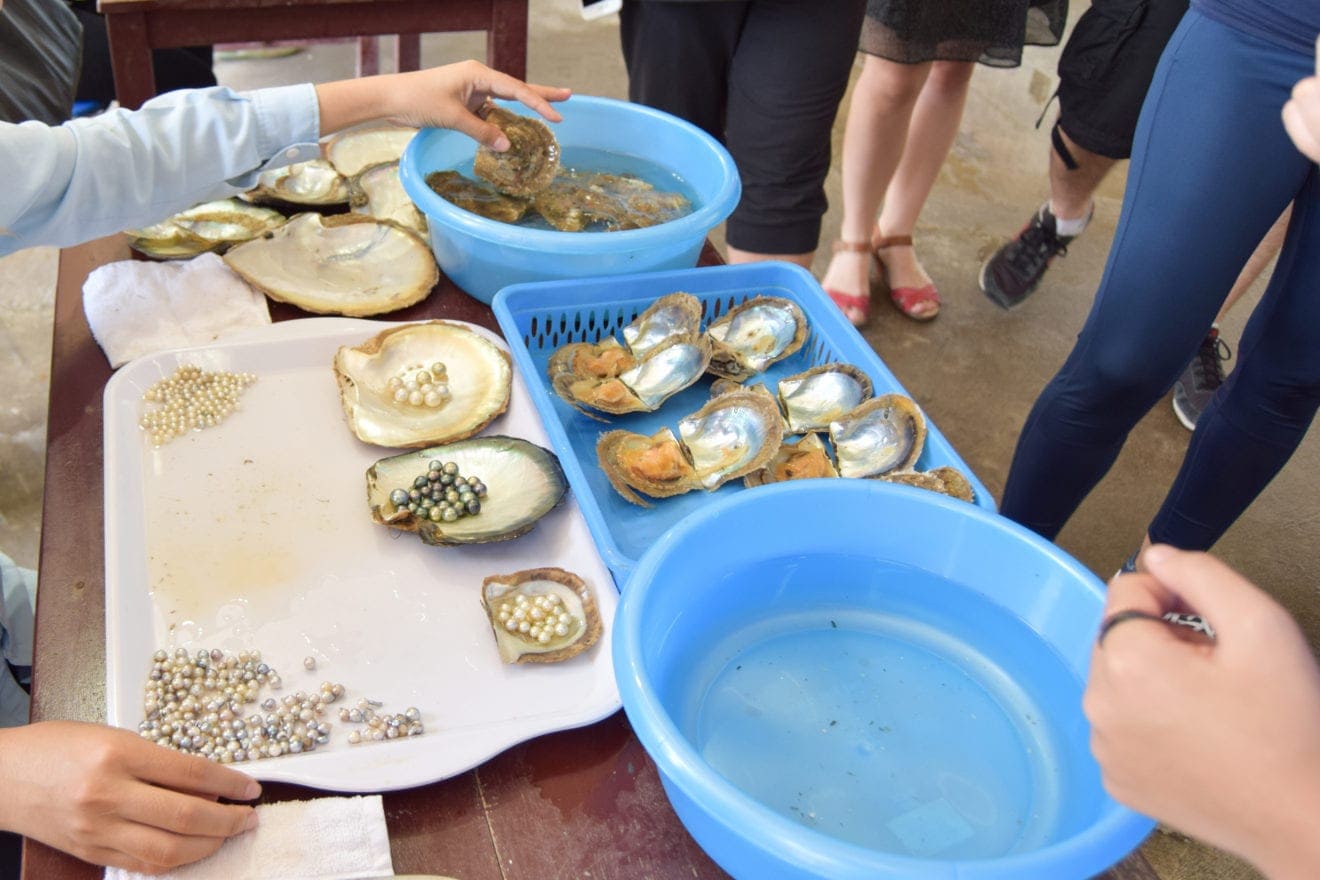One of the beautiful things about the jewelry industry today is how excellent most gemstone grading systems are.
This is one of the things that makes jewelry and gemstone shopping today such an excellent experience for customers and sellers alike – a good grading system allows both parties to know exactly what the quality of the product is and what its price should be.
So, is pearl grading the same?
Unfortunately, the answer here is not just “No” but “Hell no!” The various pearl grading systems used in the industry today are often a mess that it can make the purchase of pearls a challenge.
Pearl grading systems are meant to help but because of the lack of uniformity in the industry, as well as the opportunism of many pearl sellers, the end result for the customer is usually just confusion.
Let’s take a look.
What Are The Different Types Of Pearl Grading?
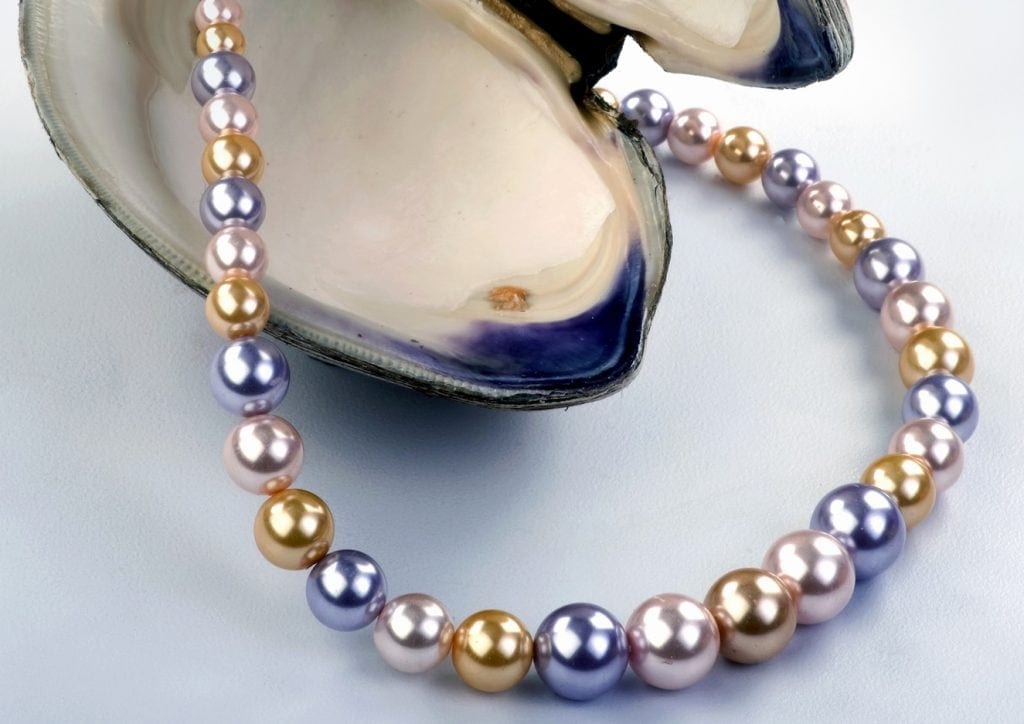
Most pearl sellers tend to use completely different grading systems or variations of the few established systems to a point where no two sellers’ grading systems are the same.
Still, there are a couple of grading systems form the backbone of pearl grading – the Hanadama, AAA, AA, A System and the Tahitian A – D system. We’ll go into detail for both of them below.
Certain gemstone grading associations such as the Gemological Institute of America (GIA) employ a more specific and comprehensive standard when grading methods that examine the main factors that determine the value of a pearl.
Unfortunately, even though the GIA and other similar gemological institutes around the globe have been using and perfecting such systems for the past 60 years, they are still not even close to being widely used by manufacturers and sellers worldwide.
Why Isn’t There Are A Uniform Pearl Grading System In Place?
This is a valid question considering that pearls have been collected and used in jewelry for millennia.
One reason is that there are several different types of pearls that can be hard to compare against one another. The main factors that certain pearl types differ in are size and nacre thickness but there are also shape and luster as well.
Another important reason is the fact that the different – mostly Asian and Pacific – countries that manufacture and sell pearls have their own individual grading systems that they insist upon. This makes it significantly harder to establish a uniformed international standard for all pearls manufacturers and sellers.
What Are The Main Factors That (Should) Go Into A Good Pearl Grading System?
Similar to the famous 4 Cs that go into the grading of diamonds and gemstones, there are 7 main factors that contribute to the value and price of a pearl.
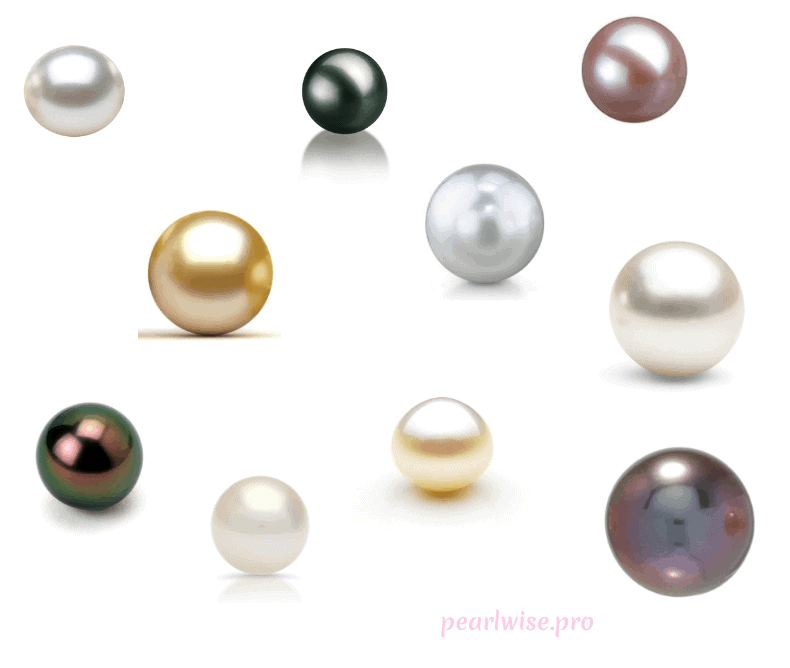
- Luster: Like other gemstones, luster is one of the most important factors for a pearl’s value. The sharper, brighter, and more reflective a pearl’s luster is, the better.
- Surface blemishing: Pearl inclusions are not as visible and noticeable as most inclusions in other gemstones. For one, they are typically white or colorless which helps them blend in with the rest of the pearl. Still, they are noticeable upon inspection even with a naked eye, so the clearer a pearl’s surface is, the better.
- Color: In the past, certain colors such as the black Tahitian pearls were valued above all else because of their rarity. The way a pearl’s color contributes to its value is in how rich and deep it is. Pearls of all colors are highly valued when their color is deep, strong, and saturated.
- Shape: While a lot of people enjoy the uniqueness of baroque pearls, perfectly round pearls are generally valued above all else.
- Size: Pearls range in size from 1mm to 20mm or more. In general, larger pearls take longer to grow and are more valuable than smaller ones.
- Natural or cultured: In terms of their physical characteristics, there isn’t much difference between natural and cultured pearls. However, because natural pearls are exceedingly rare and are formed without human interferance, they are more valued by customers and industry professionals alike.
- Pearl matching: This last factor indicates how well pearls match with each other. This is important as pearls are typically used in groups in strands. Even pearls used in pairs for earrings still need to match together in terms of their shape, size, color, and luster. Even if two pearls are both highly graded for their individual qualities, they can be poorly graded as a pair for earrings if they don’t match well.
Pearl Grading For Akoya Pearls
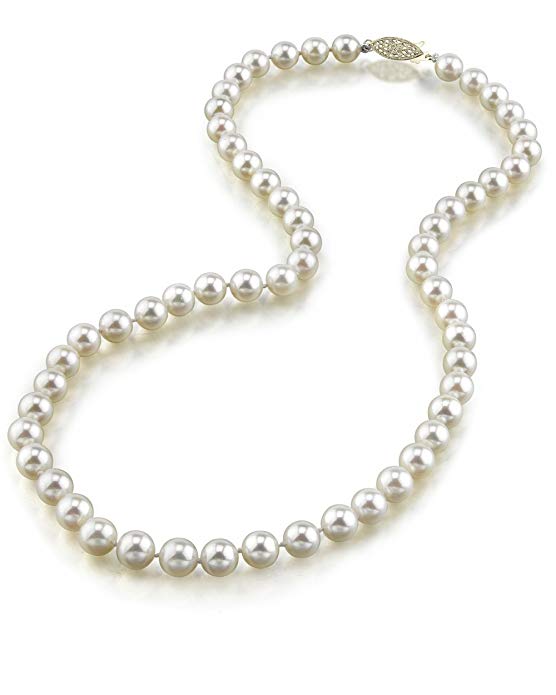
The perfect Akoya pearl strand. See it here.
The standard grading for Akoya pearls is the Hanadama or AAA, AA, A grading system. It examines the pearls’ surface quality, luster, and shape, as well as nacre thickness with a minimum nacre thickness of 0.4mm on each side (0.8mm in diameter) being required for a good quality grade.
- The Hanadama grade is the highest this system can offer, and it’s designated only to pearls that pass the extensive tests of the Pearl Science Laboratory of Japan. Akoya pearls need to be nearly flawless to earn this grade.
- AAA is a grade for Akoya pearls that have at least 95% of inclusion-free surface area, a perfectly round shape, an excellent mirror-like luster, and a nacre thickness of at least 0.4mm per side similar to Hanadama pearls.
- AA Akoya pearls have a very high luster, a 75% surface area without any defects, and a good, nearly round shape.
- A is the lowest pearl grade in this system, and it’s used for pearls with about 25% defect-free surface area, a more chalky appearance due to an imperfect luster, and thin nacre layers.
- Pearls of lower quality don’t get a grade and are either sold in beading stores or are ground into nacre dust for use in makeup and other beautifying aids.
Some retailers add other categories like AAA+ or AAAAA. These are just to make the pearl seem as though its even better than the standard AAA and are priced to perfection.
Pearl Grading For Freshwater Pearls
Freshwater pearls typically use the same A-AAA system as Akoya system with a couple of differences.
- There is no Hanadama grade for freshwater pearls.
- The thickness of freshwater pearls is not judged on the same standard as they are both smaller than Akoya pearls and have much thicker nacre layers.
Pearl Grading For Tahitian Pearls And South Sea Pearls
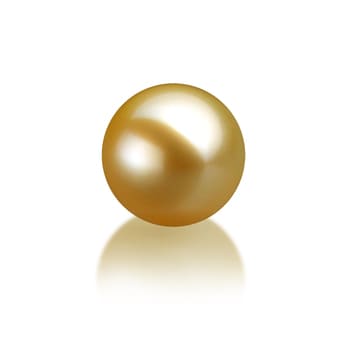
The Tahitian A-D grading system is the other big alternative to the A-AAA (Hanadama) grading system and it’s typically used for Tahitian and South Sea pearls. This system grades pearls on a scale from A to D with A being the highest possible grade and D – the lowest.
- A graded pearls in the Tahitian system have an excellent luster and only minor imperfections with at least 90% perfectly clear surface.
- B graded pearls have a high or medium luster and at least 70% of their surface should be perfectly clear of inclusions and other imperfections.
- C graded pearls have an only medium luster and about 60% of their surface is clear of imperfections with the other 40% having visible defects.
- D graded pearls have visible defects over 60% of their surface with the other 40% being clear. The luster of these pearls is usually inconsequential as the high number of inclusions will deem them D-graded even if they have excellent luster.
- Pearls of even lower quality don’t get the D grade and are not commercially sold.
Like the A-AAA system, the Tahitian grading system also focuses mostly on surface quality and luster. However, it also has higher requirements for nacre thickness because the South Sea and Tahitian pearls are typically bigger. Tahitian pearls need to have a nacre thickness of at least 0.8mm on each side or the government of French Polynesia prohibits them from being sold.
What Are The Highest Quality Pearls And How To Find Them?
From all this it’s clear that for a pearl of any type to be deemed to be “high-quality” it needs to be:
- Large in size cooperated to the standard of its type.
- Have a highly reflective luster and as few inclusions as possible.
- Be as close to being perfectly round as possible.
- Have excellent body color and overtone.
Because of the sad state of official pearl grading, it’s best to be very careful and observant when purchasing pearls and pearl jewelry. Always purchase from a reputable retailer known for the quality of their pearls. It’s also important that the jeweler stand by their product with a good returns policy.
Here’s a recap on the two types of pearl grading systems:
